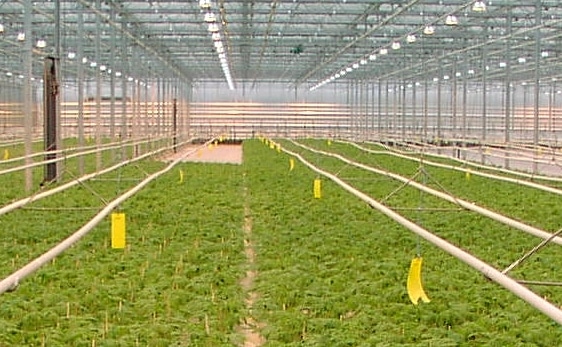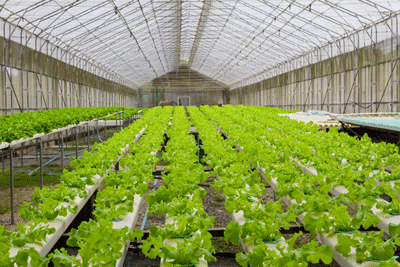Greenhouse Farming Information:

Greenhouse Farming Information- Introduction: – What is Greenhouse? A greenhouse is a framed or inflated structure covered with a transparent or translucent material in which fruit or vegetable or flower crops can be grown under the controlled climatic conditions of at least a partially controlled environment. The greenhouse is an area in which it permits a person to work and carry out regular cultural operations.
For a complete cost & profits of the greenhouse farming Information: Read here.
Greenhouse Farming Information – Advantages:- Greenhouse farming is picking very rapidly due to its advantages. The following are some of the Greenhouse benefits.
- Crop cultivation can be carried out under a controlled environment.
- Greenhouse provides an excellent opportunity to grow high-quality crops for export markets.
- Greenhouse environment is suitable for cultivating crops year-round to meet the market demands
- Greenhouse provides the best opportunity within the limited land resources
- Greenhouse provides successful nurseries from by vegetative or seeds propagation
- In Greenhouse farming, high yielding is possible with a low area of cultivation
- Farming in Greenhouse can provide local employment for educated youth.
- The greenhouse also provides an opportunity to learn about high yielding cultivation
- The greenhouse is the best place for the evolution of new varieties and the production of seeds
Greenhouse Farming Information -Types of Greenhouses:- Greenhouse type is categorized based on covering material, environmental control, shape and structure, and cost.
Let us get into details of Greenhouse types.
Greenhouse types based on covering material: The following are the types of Greenhouse based on covering material.
- Polyhouse
- Fiber-reinforced plastic house
- Glasshouse

Greenhouse types based on cost: The following are the Greenhouse types based on the cost.
- Low cost: Up to Rs. 500/sq.meter
- Medium cost: From Rs. 500 to 1000 /sq.meter
- High cost: Above Rs. 1000/sq.meter.
Greenhouse types based on shape & structure: The following are the Greenhouse types based on the shape and structure.
- Gable
- Gothic arch
- Lean-to
- Even span
- Single-span
- Quonset
- Double-span (or) multi-span.
Greenhouse types based on environmental control: The following are the Greenhouse types based on environmental control.
- Naturally ventilated greenhouses
- Evaporatively cooled greenhouses
- High-tech greenhouses.
Greenhouse Farming Information – Site Selection:- Selecting a perfect site is the most important part of Greenhouse farming:
- The Greenhouse should be well connected with roads and local markets.
- The greenhouse should not be built in waterlogged areas
- Avoid the areas where heavy winds are possible to prevent or minimize the wind damage
- Make sure the site is well-drained in case of heavy rains or floods.
- Avoid constructing a Greenhouse near industry to prevent possible pollution effects on Greenhouse crops.
- Make sure to have sufficient room for future site expansion
- As labour is an integral part of the greenhouse, make sure to have availability of labour.
- The site should have communication facilities like telephone, fax, and internet.
Greenhouse Farming Information – Orientation of Greenhouse:- The following is the preferred orientation of the Greenhouse.
- In the naturally ventilated greenhouse, the ventilators should open on the leeward side
- In a free-standing greenhouse, it should have its long axis perpendicular to the wind direction
- In a multi-plan greenhouse, the gutter should be oriented north-south direction
- In the free-standing greenhouse, more sunlight is available in winter in an east-west direction
Greenhouse Farming Information – Environmental Control:- The following are the means of controlling the environment in the Greenhouse.
- Sprinkling water on the cover
- Natural ventilation can be provided by using ventilation nets & ridge openings
- Mechanical ventilation can be provided by exhaust fans and mixing fans
- Air conditioners can be used in hi-tech Greenhouse for very high-value crops
- For Shade control, shade nets or thermal screens can be used
- Overhead misting or fogging system can be used
- In dry climates, fan-pad cooling can be used.
Greenhouse Farming Information – Maintenance:- Maintenance in Greenhouse farming is very important and a little expensive too.
- Because of the dust, biofilm reduces the transmittance of covers. Hence the covers should be washed periodically
- The PE covers lose their transmissivity within five years period so they need to be replaced
- The greenhouse should be fumigated & the soil should be solarized by mulching every year
- In a Greenhouse, fertigation should be used for fertilizer application and irrigation
- UV stabilized insect nets over all vents and openings, Insect traps /biological control is mandatory
- The drip irrigation system should be flushed & cleaned periodically
- Providing an insect-proof net to facilitate ventilation by keeping the inside greenhouse door open is essential.
Difference between Greenhouse and Polyhouse:- Greenhouse is a broad term and Polyhouse is one type of greenhouse made out of polyethylene, it can also be with a wood called Lath house & with glass it is called Greenhouse.
Greenhouse Farming Information – Subsidy:- Most of the state governments encouraging greenhouse cultivation by providing subsidies. For subsidy information on the greenhouse, contact the local horticulture department.
For complete low-cost greenhouse farming Information: Read here.
In case if you are interested in this: How To Grow Organic Lettuce.
- Economical Aquaculture: A Guide to Low-Budget Fish Farming
- 15 Common Planting Errors That Can Doom Your Fruit Trees
- How to Make Houseplants Bushy: Effective Tips and Ideas
- Innovative Strategies for Boosting Coconut Pollination and Yield
- Pollination Strategies for Maximum Pumpkin Yield
- The Complete Guide to Chicken Fattening: Strategies for Maximum Growth
- Natural Solutions for Tulip Problems: 100% Effective Remedies for Leaf and Bulb-Related Issues
- Revolutionizing Citrus Preservation: Towards a Healthier, Greener Future
- Natural Solutions for Peony Leaf and Flower Problems: 100% Effective Remedies
- Maximizing Profits with Avocado Contract Farming in India: A Comprehensive Guide
- Natural Solutions for Hydrangea Problems: 100% Effective Remedies for Leaf and Flowers
- The Ultimate Guide to Choosing the Perfect Foliage Friend: Bringing Life Indoors
- From Sunlight to Sustainability: 15 Ways to Use Solar Technology in Agriculture
- The Ultimate Guide to Dong Tao Chicken: Exploring from History to Raising
- The Eco-Friendly Makeover: How to Convert Your Unused Swimming Pool into a Fish Pond
- Mastering the Art of Delaware Chicken Farming: Essentials for Healthy Backyard Flocks
- 20 Best Homemade Fertilizers for Money Plant: DIY Recipes and Application Methods
- How to Craft a Comprehensive Free-Range Chicken Farming Business Plan
- Brighten Your Flock: Raising Easter Egger Chickens for Beauty and Bounty
- How to Optimize Your Poultry Egg Farm Business Plan with These Strategies
- Subsidy for Spirulina Cultivation: How Indian Government Schemes Encouraging Spirulina Farmers
- Ultimate Guide to Raising Dominique Chickens: Breeding, Feeding, Egg-Production, and Care
- Mastering the Art of Raising Jersey Giant Chickens: Care, Feeding, and More
- Ultimate Guide to Raising Legbar Chickens: Breeding, Farming Practices, Diet, Egg-Production
- How to Raise Welsummer Chickens: A Comprehensive Guide for Beginners
- How to Protect Indoor Plants in Winter: A Comprehensive Guide
- Ultimate Guide to Grow Bag Gardening: Tips, Tricks, and Planting Ideas for Urban Gardeners
I would like to be a Hydrponic Entrepreuner. Would like to know about set up cost for 1000 sqft area and recurring cost and the revenue i can generate if i do all the things right.
You can read here about some information about Hydroponic Farming.
We update cost and profit details of hydroponics soon.
Kindly share your experience with us as regards storing up to 12tons of Sesame seeds for a year plus, without going bad.
How to maintain the RH in a green house In my green house RH goes down to 28-30 its badly effect on my breeding program